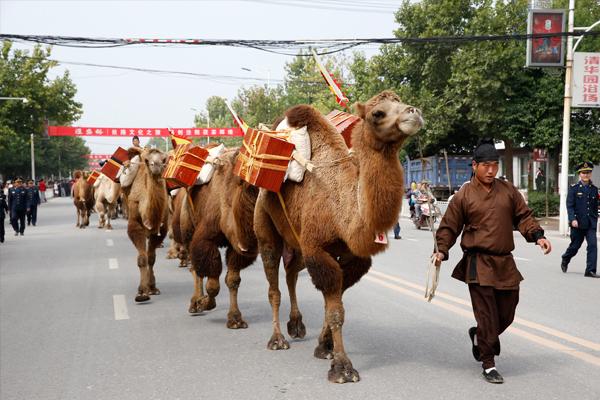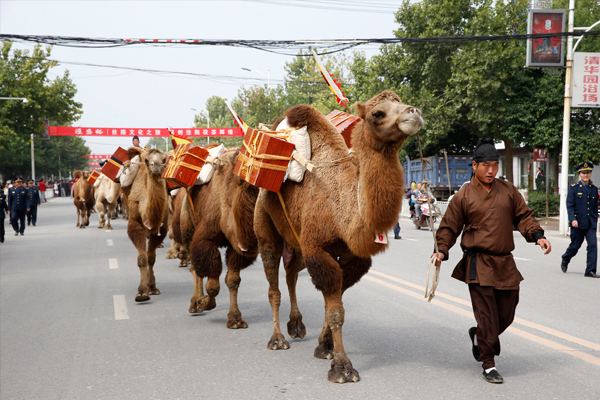
Through its ‘One Belt, One Road’ project, China is looking to take its construction binge offshore, report Brenda Goh and Koh Gui Qing
Two years after China unveiled a sweeping plan to rebuild Silk Road trade links with Europe and Asia, machinery maker XCMG Group has opened a factory in Uzbekistan, sent 300 staff abroad, and set ambitious goals to grow overseas.
XCMG’s foreign venture piggybacks on China’s bold scheme to extend its global influence through financing infrastructure projects in 65 nations that are home to two-thirds of humanity, and at the same time win new markets for companies weighed down by profit-crushing overcapacity at home.
“This is China’s grand strategy,” said Hanson Liu, assistant president at Xuzhou Construction Machinery Group, which aims to grow overseas income from 15 percent of total revenue in 2014 to more than 30 percent in the next five years.
“It’s like how a person in a village has gotten rich and wants to fix roads, build power points, street lamps for the neighbourhood.”
Stretching from Hungary to Indonesia, Beijing estimates its much-hyped “One Belt, One Road” initiative will add a $2.5 trillion to China’s trade in the next decade, more than the value of its exports in 2013 – when it was the world’s top exporter.
While it is too early to assess whether that lofty goal will be realised, the drive offshore is already proving a boon for firms like XCMG, whose listed unit, XCMG Construction Machinery , has posted three years of declining sales.
“Our company, from top to bottom, is focused on this,” said Liu in an interview at XCMG’s campus in Xuzhou, an industrial city in coastal Jiangsu province where the government-owned firm, one of China’s biggest heavy machinery makers, is the largest employer.
Back to topCRIPPLING OVERCAPACITY
After years of breakneck growth, the extent of China’s overcapacity problem is becoming clear as waning domestic demand and efforts to re-tool the economy slows growth to a pace dubbed by President Xi Jinping as the “new normal”.
That has exposed supply gluts that are especially glaring in the steel, coal and cement sectors, where factories have the capacity to produce up to 30 percent more than current demand, official data showed.
“One Belt, One Road” – the name comes from abbreviating the two planks of the scheme, the “Silk Road Economic Belt” and the “21st Century Maritime Silk Road” – aims to carve out new markets for goods that China makes too much of.
There is evidence, from companies and data, that some effect is already being felt.
Auditing firm PWC estimates that more than $250 billion worth of projects, from railways to power plants, have been contracted since “One Belt, One Road” was announced in 2013.
Buoyed with a $50 billion credit line from the Bank of China for such projects, China’s largest cement maker, Anhui Conch, is building at least six cement plants in Indonesia, Vietnam and Laos, according to its website.
Steel firms have also said that they are looking to ramp up foreign acquisitions to move capacity to regions such as Southeast Asia and Eastern Europe.
In Shijiazhuang, the capital city of Hebei province, which surrounds Beijing and is China’s biggest steel producer, steel exports spiked almost 50 percent to 36.5 billion yuan in the first seven months this year.
The number of Chinese workers employed abroad by Chinese firms shot up by 18 percent to 1 million last year, having crept up by just 4 percent in 2013, commerce ministry data showed.
Back to topFANTASY ROAD?
But while firms like XCMG, which were already active overseas, are finding “One Belt, One Road” hits a sweet spot, others are struggling to gain a foothold.
Eight steel mills in Hebei who spoke to Reuters said the scheme was not increasing demand enough to solve their biggest problem, low prices caused by excess supply.
“There has been a little impact from ‘One Belt, One Road’, but it is not evident,” said a manager at one steel mill. “The market involved is too big, and now it’s more just a concept.”
The infrastructure drive also risks running counter to another of Beijing’s policy goals, reforming China’s state-run giants - the very firms expected to win the bulk of “One Belt, One Road” deals struck between governments, according to a manager at another steel mill in Hebei.
Local brokerages estimate that up to 1.5 trillion yuan ($235 billion) in state funding has been committed to the initiative so far in investments, grants and loans, some of which will be dispersed through Beijing’s new policy lender, the Asian Infrastructure Investment Bank.
That’s about a 20th of the stimulus spending unleashed by Beijing in response to the global financial crisis, said Brian Jackson, a senior economist at IHS, adding it was “a bit of fantasy” to believe the scheme could be a panacea for China’s deep structural problems of overcapacity - created in part by that earlier splurge.
Still, executives like Zhou Junjia, a sales manager with Baifeng Iron and Steel Corporation, say any kind of help is welcome as they look to break out of their crowded home market.
“We don’t mind whether it is ‘One Belt, One Road’ or something else,” he said. “As long as it gives us more export opportunities.”
Back to top
CHINA ISSUES GUIDANCE TO BOLSTER NEW SILK ROAD, REGIONAL DEVELOPMENT
By Shu Zhang and Matthew Miller
China’s government has rolled out fresh guidance aimed at supporting its new Silk Road infrastructure initiative, along with regional development in the Beijing-Tianjin-Hebei area and the Yangtze River economic corridor that includes Shanghai.
The government said it will speed up approvals for major construction projects and strengthen bank credit policies for investments in those regions, in policy guidance issued by the China Banking Regulatory Commission and the National Development and Reform Commission, the government’s top planning agency.
China is seeking to extend its influence and to support domestic industry through its “One Belt, One Road” initiative, which aims to create a modern Silk Road trade route across central, west and south Asia.
The new policy will bolster demand in China’s infrastructure sector as concern mounts over flagging economic growth. Activity in the factory sector shrank at its fastest pace in almost 6-1/2 years in August, according to a recent private survey.
Projects under the plan include a network of railways, highways, oil and gas pipelines, power grids, Internet connections, and maritime and other infrastructure links extending as far as Greece, Russia and Oman, increasing China’s connections with Europe and Africa.
Banks will be encouraged to securitise assets and clear non-performing loans to increase lending to long-term development projects, Ye Yanfei, an inspector at the banking regulatory commission’s policy research bureau, told reporters. Ten new local asset management companies would facilitate the process, he said.
Projects targeted for support include environmental protection, forestry and water conservancy, and construction of central and western Chinese railways, the document said.
China Development Bank Corp, the country’s biggest policy lender for large infrastructure investments, is expected to boost lending to 2 trillion yuan ($313 billion) this year, Lu Xin, deputy head of the bank’s business development unit, told a news conference hosted by the banking regulator.
President Xi Jinping said in March that he hoped China’s annual trade with the countries in the new Silk Road initiative would surpass $2.5 trillion in a decade.
Friday’s guidance also outlined support for Xi’s proposal to integrate the areas of Beijing, Hebei and Tianjin to help ease Hebei province’s dependence on highly polluting heavy industries, a source of hazardous smog throughout the region.
The three local administrations and their transportation networks would be more closely integrated, as the capital shifts industrial enterprises, factories and even government departments into neighbouring cities. The plan will also relocate heavy industries such as steel to China’s east coast.
Back to top
SILK ROAD NO STAIRWAY TO HEAVEN FOR CHINA’S MACHINERY MAKERS
By Fang Yan and Matthew Miller
China’s pledge to support the Silk Road infrastructure initiative with $40 billion worth of investments may not be enough to revive the struggling heavy machinery industry as it battles over-capacity stemming from legacy investment.
Projects under the plan include a network of railways, highways, oil and gas pipelines, power grids, maritime and other infrastructure links across central, west and south Asia to as far as Greece, Russia and Oman.
Industry players and analysts said that although the contracts would bring benefits in the long run, they were not a quick fix for the heavy machinery sector’s troubles.
“There are too many machines out there in the market,” Zoomlion Heavy Industry Science and Technology Chairman Zhan Chunxin told Reuters.
“Companies tended to get orders ahead of a major infrastructure projects previously, but now we hardly get any inquires even if several projects kick off at the same time.”
Encouraged to expand after Beijing fired up a 4 trillion yuan ($644 billion) stimulus package in 2008, Sany Heavy Industry Co, Zoomlion and others are stuck with a glut of unsold equipment, factories they do not need and tumbling earnings.
“We face unprecedented challenges. It’s no exaggeration at all to say that the Chinese market is in the middle of a catastrophic long-term slump,” Zeng Guangan, chairman of Guangxi Liugong Machinery Co, told a recent industry forum.
Zoomlion warned about a 300 to 380 million yuan loss in the first half, versus a 900 million yuan net profit a year earlier.
China’s top bulldozer builder Shantui Construction Machinery Co expects to swing to as much as 310 million yuan loss from a 59 million yuan profit a year earlier. XCMG Construction Machinery’s earnings could drop as much 99 percent.
Last year, China’s overall production capacity for wheel loaders amounted to 420,000 units, 2.6 times as much as global sales for the year. Capacity for excavators topped 538,000 units, far exceeding global sales of 418,500 units, according to industry consultancy Off-Highway Research.
The country’s construction machinery sales, meanwhile, were only $17 billion last year, less than half the 2011 level. They are expected to fall further to $13 billion this year and claw back to modest growth in the next two years, it said.
“While the sector consolidates, we expect more cases of mergers and acquisitions, and diversification in the coming years,” said Alexious Lee, head of China machinery research at CLSA.
Back to top


